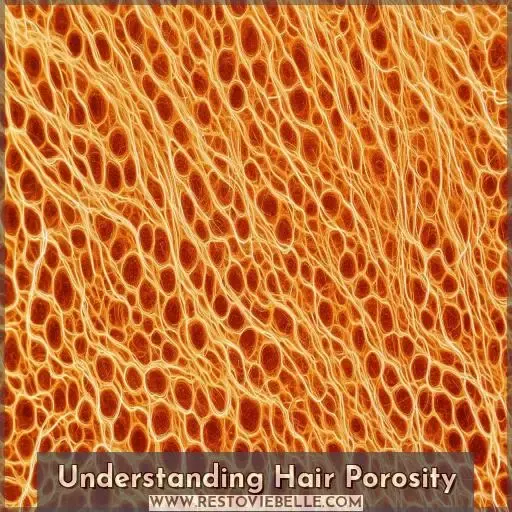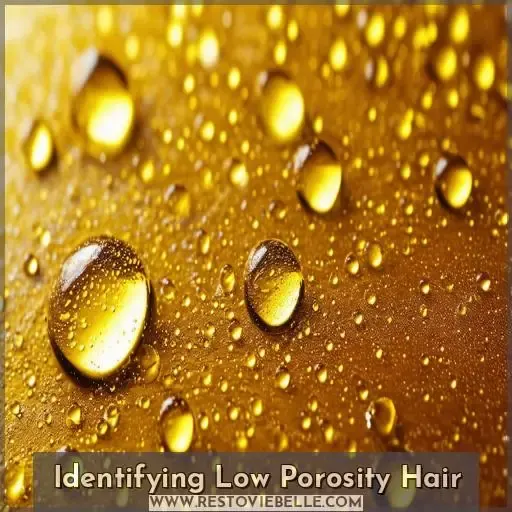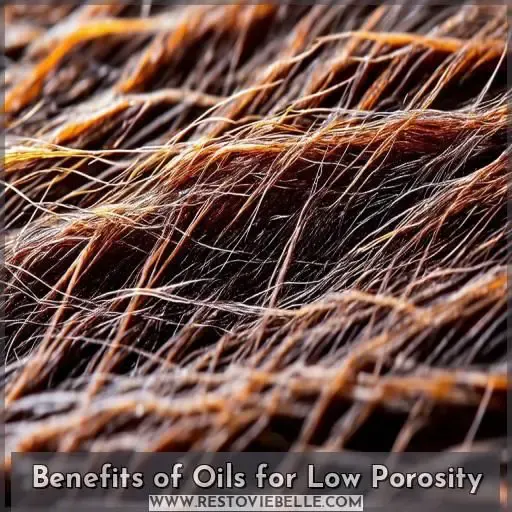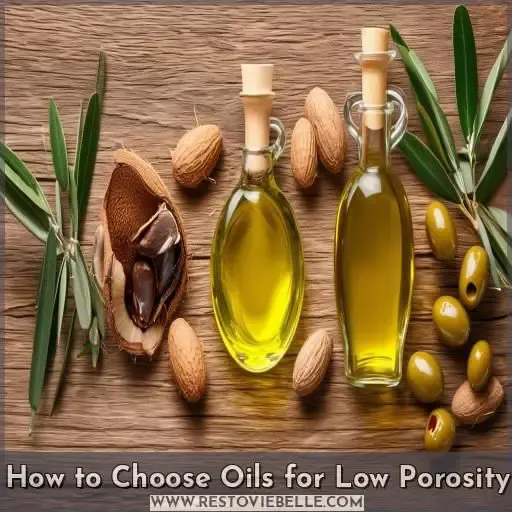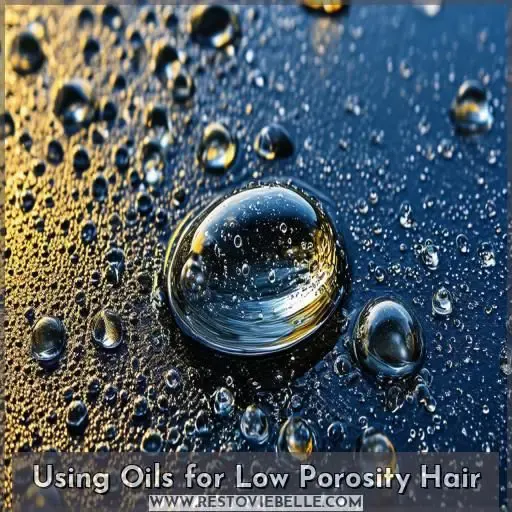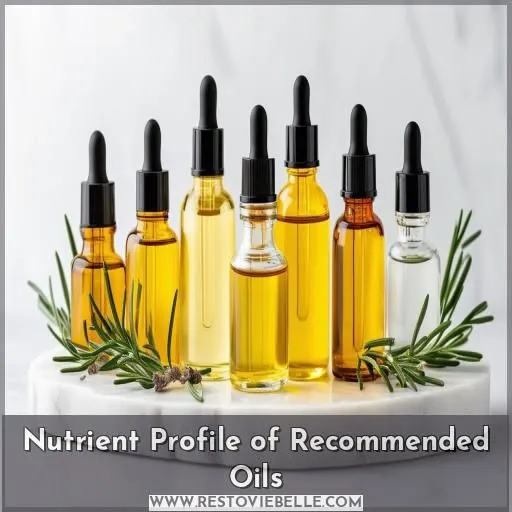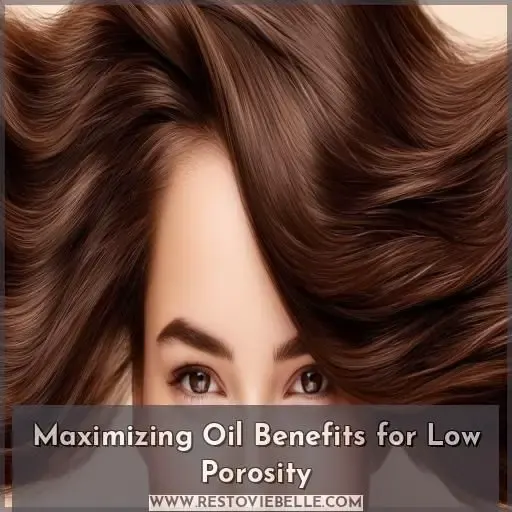This site is supported by our readers. We may earn a commission, at no cost to you, if you purchase through links.
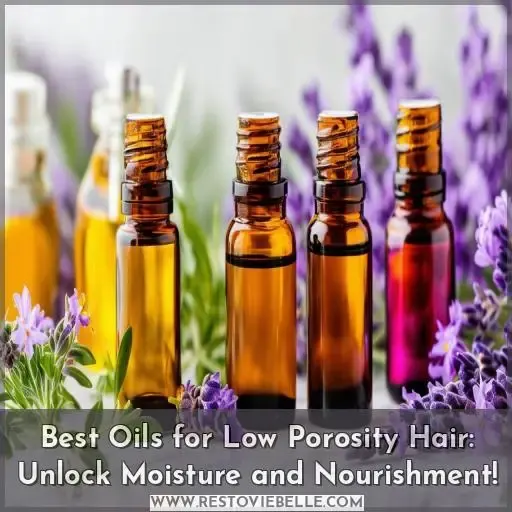 For best oils for low porosity hair, choose lightweight, penetrating options like grapeseed, jojoba, and argan oil.
For best oils for low porosity hair, choose lightweight, penetrating options like grapeseed, jojoba, and argan oil.
These deeply moisturize without weighing strands down, promoting healthy growth.
You’ll want to avoid heavy oils like coconut and olive, which can cause buildup and hinder moisture absorption.
To nourish and release moisture for your tightly-packed cuticles, look for oils that’ll seep in with ease, refresh your scalp, and retain hydration.
Want to learn more about maximizing oil benefits suited to your hair’s unique porosity? Let’s delve into the topic.
Table Of Contents
- Key Takeaways
- Best Oils for Low Porosity Hair
- Understanding Hair Porosity
- Identifying Low Porosity Hair
- Benefits of Oils for Low Porosity
- Oils to Avoid for Low Porosity
- How to Choose Oils for Low Porosity
- Using Oils for Low Porosity Hair
- Nutrient Profile of Recommended Oils
- Maximizing Oil Benefits for Low Porosity
- Frequently Asked Questions (FAQs)
- Conclusion
Key Takeaways
- Lightweight, penetrating oils like grapeseed, jojoba, and argan are your low porosity locks’ best friends. They’ll quench your hair’s thirst without clogging those stubborn cuticles – imagine a crisp glass of water on a scorching summer day!
- Stay away from heavy hitters like coconut and olive oil. They may be popular choices, but for your low porosity strands, it’s like trying to shove a giant marshmallow through a tiny keyhole. No bueno!
- Don’t just slather on any old oil and call it a day. Prep your mane like a pro with techniques like pre-pooing, hot oil treatments, and the LCO method. Your strands will drink it all up and thank you later!
- Knowledge is power, my friend. Understanding your hair’s porosity level is key to unlocking the secrets of optimal moisture and nourishment. Conduct the water test or get up close and personal with your strands – it’ll be an eye-opening experience!
Best Oils for Low Porosity Hair
You’ve likely heard of Righteous Roots Hair Oil – it’s a standout product for those with low porosity locks. Formulated with lightweight yet nourishing oils like grapeseed, jojoba, and argan, this oil penetrates stubborn strands to deliver essential moisture and nutrients.
1. Righteous Roots Hair Oil
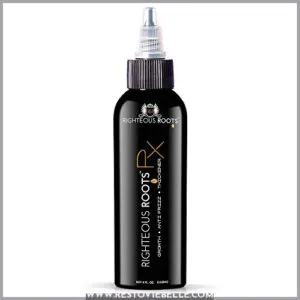
You’re seeking the ideal oil to nourish your low porosity hair. Righteous Roots Hair Oil is a potent blend of coconut, castor, olive, avocado, grapeseed, and more!
It’s akin to gifting your strands an opulent spa day. This formula permeates the cuticle, sealing in moisture while fostering healthy growth.
Bid farewell to dryness and frizz – unveil your hair’s true radiance with this ultra-nourishing elixir.
Best For: Individuals seeking a nourishing oil for their low porosity hair.
- Rich blend of 11 oils for deep conditioning and moisture retention
- Promotes healthy hair growth and reduces dryness
- Refreshes the scalp with peppermint and rosemary scent
- May be too heavy for some hair types
- Pricey compared to other hair oils
- Not specifically formulated for curly or frizzy hair
Understanding Hair Porosity
Understanding hair porosity is essential for selecting the right oils and achieving ideal moisture levels.
Your hair’s porosity refers to its capacity to absorb and retain water and oil. It’s determined by the arrangement of the cuticle layer.
Low porosity hair has tightly-packed cuticles that resist moisture absorption, leading to dryness and difficulty managing it.
However, with the appropriate knowledge and oils suited to your porosity, you can achieve nourishment and manageability.
Lightweight, penetrating oils are key for low porosity strands as they bypass the cuticle resistance and provide essential moisture and nutrients without causing lipid buildup or protein overload.
Stay tuned as we explore identifying low porosity hair next.
Identifying Low Porosity Hair
To identify if you have low porosity hair, perform the water test by dropping a strand of hair into a glass of water – if it floats, it’s likely low porosity. You can also observe your hair’s texture; low porosity hair tends to be smooth and shiny.
The Water Test
The water test is a simple way to reveal low porosity hair. Cut a small strand and drop it into a glass of water. If it floats, your hair is low porosity – the cuticles are tightly packed, making it difficult for water to penetrate. This test reveals:
- How porous your strands are
- Their ability to absorb moisture
- The best products for your hair type
- If clarifying shampoos could be beneficial
Knowing your porosity level grants access to the secrets of healthy, hydrated locks.
Observation
Examining your hair’s appearance offers clues about its porosity. Low porosity locks have a smooth, glass-like sheen from cuticles lying flat. The cuticle layer closes tightly, hindering water absorption and moisture retention. Your hair may feel coarse, brittle, and challenging to manage, signaling its porosity level affects overall health and manageability.
| Hair Appearance | Porosity Level |
|---|---|
| Smooth, shiny | Low |
| Rough, dull | High |
| Frizzy, dry | High |
| Feels coarse | Low |
| Damaged strands | High |
Benefits of Oils for Low Porosity
Are you struggling to keep your low porosity hair moisturized and nourished? The right oils can work wonders by retaining moisture, promoting scalp health, and protecting your strands from damage.
Moisture Retention Properties
You need oils that deeply moisturize low porosity hair without weighing it down. These oils penetrate hair strands, preventing breakage and combating dryness. Unlike heavy oils like coconut oil that sit on top, lighter oils help retain moisture within the hair structure, promoting overall health and texture.
Nourishing Scalp Health
Nourishing your scalp is essential for healthy low porosity hair. Oils like jojoba and rosemary oil provide excellent scalp nourishment. They promote oil absorption and hair softening, ensuring moisture retention and ideal cuticle arrangement during a scalp massage.
- Promotes healthier scalp
- Enhances oil absorption
- Softens hair
- Improves moisture retention
Strand Protection Benefits
To thoroughly protect your strands, essential oils like jojoba and grapeseed offer critical benefits. They facilitate oil absorption and shield against damage, ensuring moisture retention and enhanced nutrient absorption. This prevents breakage while maintaining scalp health. For best results with low porosity hair, integrate these oils into your routine for apparent improvements in hair moisture and nourishment.
Oils to Avoid for Low Porosity
When caring for low porosity hair, avoid heavier oils like coconut oil, shea butter, olive oil, Jamaican Black Castor Oil, and mineral oil, as these can block moisture absorption and weigh your hair down. Opt for lightweight, hydrating oils that effectively penetrate and nourish your strands (Source).
Coconut Oil
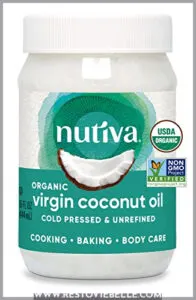
Despite its popularity, coconut oil can cause greasy buildup and hinder moisture absorption for low porosity hair . Its heavy nature leads to product buildup, potentially resulting in hair breakage and dryness . Opt for lighter, highly penetrating oils to guarantee proper hair moisturizing and nourishment (Source).
Shea Butter
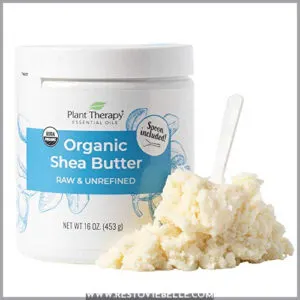
Shea butter isn’t ideal for low porosity hair. Despite its moisture-rich properties, its thick, heavy composition can cause buildup, blocking moisture absorption. Instead, opt for lightweight oils that better penetrate the tight cuticle of low porosity hair. These alternatives guarantee effective moisture retention, enhanced scalp health, and superior strand protection, avoiding the drawbacks of shea butter.
Olive Oil
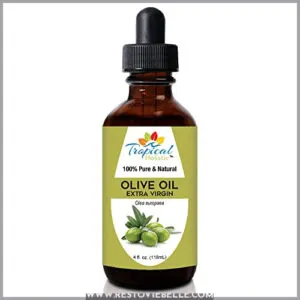
Moving away from shea butter, let’s address olive oil for low porosity hair. Despite its known benefits, it’s too heavy, leading to product buildup. It can create a barrier, restricting moisture absorption essential for your hair’s health. Instead, use oils that penetrate well, retaining moisture and enhancing shine and softness while reducing frizz.
Jamaican Black Castor Oil
Jamaican Black Castor Oil is a no-go for low porosity hair. It’s thick and heavy, making it hard for your hair to absorb. Stick to lighter oils instead to avoid buildup.
- Causes buildup
- Too heavy for absorption
- Makes hair greasy
- Difficult to wash out
- Can weigh hair down
Mineral Oil
Mineral oil is a poor choice for low porosity hair, causing low absorption and weighing hair down. It can lead to breakage. Instead, opt for oils like argan oil, grapeseed oil, rosehip oil, or sunflower seed oil, which provide superior nourishment and moisture retention without the drawbacks of mineral oil.
| Oil Type | Benefits | Avoid |
|---|---|---|
| Argan Oil | Nourishes and protects | Mineral Oil |
| Grapeseed Oil | Light and hydrating | Low Absorption |
| Rosehip Oil | Rich in nutrients | Weigh Down |
| Sunflower Oil | Moisturizes effectively | Breakage |
| Mineral Oil | None | Low Porosity |
How to Choose Oils for Low Porosity
Understanding hair porosity is essential in selecting the right oil for low porosity hair. To guarantee maximum nutrient absorption, choose lightweight oils that can penetrate and moisturize effectively.
Hair Porosity Test
To choose the best oils for your low porosity hair, you need to understand your hair’s porosity. Performing a hair porosity test can help. Simply place a clean strand of your hair in a glass of water. If it floats, your hair is low porosity, indicating a tight cuticle layer that resists moisture absorption .
Oil Weight Selection
Selecting the right oil weight for your low porosity hair is essential. Choose lightweight oils like grapeseed, pomegranate, and apricot oils to prevent build-up and foster effective oil absorption. Incorporate these oils into your hair care routines with specific oil application methods that are appropriate for your hair type variation for best results. Product recommendations include grapeseed and avocado oils.
Nutrient Absorption Benefits
To maximize nutrient absorption for low porosity hair, opt for oils that are lightweight and penetrate well. Great choices include:
- Grapeseed oil: Excellent for moisture retention (Source).
- Jojoba oil: Mimics natural scalp oil.
- Baobab oil: Rich in Omega fatty acids.
- Sesame oil: Enhances scalp health with its emollient benefits .
Using Oils for Low Porosity Hair
To effectively use oils for low porosity hair, try incorporating them in pre-poo treatments, shampoos, deep conditioning, and scalp massages. Implementing the LCO method can also help lock in moisture, enhancing your hair’s health and appearance.
Pre-Poo
Pre-pooing with oils like argan or jojoba can greatly benefit low porosity hair. It helps detangle, strengthens strands, and provides humidity protection. Apply a light oil mixture (grapeseed and avocado oils) 30 minutes before shampooing, 1-2 times weekly, for ideal results. This technique seals in moisture and prepares your hair for the LOC method.
Shampoo
When incorporating oils into your low-porosity hair shampoo routine, select sulfate-free shampoos. These gentle formulas guarantee effective cleansing without removing essential moisture. Consider shampoos formulated for oil removal, guaranteeing they don’t leave residues behind.
- Cleansing techniques to remove oil buildup
- Sulfate-free shampoos for gentle care
- Clarifying shampoos for thorough cleansing
Embrace these tips for a healthy curly hair journey, regardless of hair density.
Deep Conditioning
For deep conditioning low porosity hair, opt for water-based products and coconut oil alternatives like jojoba or grapeseed oil. After clarifying, apply a DIY hair mask with these lightweight oils to guarantee better moisture absorption. This method nourishes your scalp and protects strands, providing deep hydration where it’s needed most.
Scalp Massage
Another way to nourish low porosity hair with oils is through scalp massage. It promotes:
- Hair growth by stimulating blood flow
- Dandruff reduction through gentle exfoliation
- Improved scalp health by delivering nutrients
- Enhanced shine and moisture retention
Gently massage the oil into your scalp using your fingertips for maximum benefits.
LCO Method
For the LCO method, start with a liquid leave-in, then apply your oil, sealing with a cream. Oils like argan and jojoba create the perfect protective layer for low porosity strands.
This strategic application technique maximizes your oil’s benefits, allowing it to penetrate while sealing in hydration.
Nutrient Profile of Recommended Oils
Let’s examine the nutrient profiles of the recommended oils! These oils are a treasure trove of fatty acids, antioxidants, vitamins, and minerals – all essential for low porosity hair.
Argan oil is rich in vitamins A & E, ferulic acid, and fatty acids that deeply nourish your strands.
Almond oil boasts vitamin E, zinc, proteins, and fatty acids like stearic acid that prevent moisture loss.
Jojoba oil’s fatty acid composition and antioxidant content make it an exceptional moisturizing and scalp treatment option.
Furthermore, the penetration ability of these oils allows the nutrients to seamlessly absorb into your low porosity hair.
Maximizing Oil Benefits for Low Porosity
To fully harness the benefits of oils for your low porosity hair, you’ll want to carefully select lightweight, nutrient-rich options like argan, grapeseed, or almond oil. Applying these oils correctly is key — focus on techniques like pre-pooing, using the LCO method, and determining your hair’s true porosity level.
Oil Selection Criteria
To maximize oil benefits, carefully select ones suited to your hair’s needs. Lightweight, penetrating oils like grapeseed or jojoba nourish low porosity strands. Hair serums, with their featherweight formulas, provide hydration without weighing hair down. Always study the oil’s composition – sealing oils richly seal moisture within the hair shaft.
Application Techniques Optimized
- Hot oil treatments open cuticles for better absorption
- Night oiling allows oils to penetrate deeply overnight
- Oil blending combines beneficial properties of multiple oils
- Steam treatments boost oil penetration and retention
Porosity Determining Methods
You’ll want to accurately determine your hair’s porosity to maximize oil benefits. The float test is a simple way: drop a strand in water – if it floats, it’s low porosity. Alternatively, you can snip a strand and observe the cuticle arrangement under a microscope. Low porosity hair struggles with water absorption due to tightly bound cuticles.
Frequently Asked Questions (FAQs)
What oil to use on low porosity hair?
You’ll want to opt for lightweight, penetrating oils like argan, grapeseed, or jojoba oil. These moisturize without weighing down your strands or causing buildup on your low-porosity hair.
What oils should I avoid for low porosity?
Like a locked fortress, low porosity hair resists heavy oils. Avoid coconut, olive, and mineral oils that’ll leave your strands weighed down and suffocated. Instead, opt for lightweight options like jojoba or grapeseed oil to keep your tresses happy and hydrated.
Is coconut oil OK for low porosity hair?
Coconut oil isn’t recommended for low porosity hair. Its large molecular structure prevents proper penetration, leading to product buildup and dryness. Opt for lightweight, penetrating oils like jojoba or argan instead to nourish and moisturize effectively.
Which oil penetrates the hair shaft?
Penetrating oils like coconut and sunflower oil are able to seep into your hair shaft, nourishing it from the inside out. For low porosity hair, these deeply moisturizing oils are key to preventing dryness and breakage.
How long do hair oils last?
high-quality hair oils can last 6-12 months unopened! As for opened bottles, you’ve got about 6 months to enjoy their nourishing goodness before they degrade. With proper storage, hair oils are a worthwhile investment for your luscious locks.
Can hair oils cause buildup?
Yes, hair oils can cause buildup if used excessively or if your hair isn’t thoroughly cleansed between applications. Moderation and regular washings are key to avoiding a greasy, weighed-down look.
How often should oils be applied?
You should apply oils 1-3 times per week to low porosity hair. Don’t overdo it – low porosity strands can easily get weighed down or greasy. A little goes a long way when using lightweight oils.
Are oils safe during pregnancy/breastfeeding?
As an expectant mom, you want what’s safest for your baby. Plant-based oils like argan, jojoba, and grapeseed are generally considered safe during pregnancy and breastfeeding. Still, always consult your doctor before using any new products.
Conclusion
Ultimately, your mane’s unique porosity level shouldn’t hinder achieving lustrous locks. By implementing the ideal oils for low porosity hair, you’ll empower yourself with newfound nourishment and hydration. Lightweight, penetrating oils like grapeseed, jojoba, and argan seep deep to quench parched strands from within. With proper application techniques customized to your tresses’ needs, you’re primed for an enviable hair journey.

